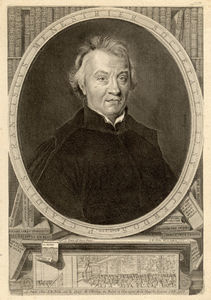According to the Wikipedia article:
The prophecy was first published in 1595 by Arnold de Wyon, a Benedictine historian, as part of his book Lignum Vitæ. Wyon attributed the list to Saint Malachy, the 12th‑century bishop of Armagh in Ireland. According to the traditional account, in 1139, Malachy was summoned to Rome by Pope Innocent II. While in Rome, Malachy purportedly experienced a vision of future popes, which he recorded as a sequence of cryptic phrases. This manuscript was then deposited in the Roman Archive, and thereafter forgotten about until its rediscovery in 1590.On the other hand, Bernard of Clairvaux's biography of Malachy makes no mention of the prophecy, nor is it mentioned in any record prior to its 1595 publication. This has led to many, including the most recent editions of the Catholic Encyclopedia, to suggest that the prophecy is a late 16th‑century forgery. Some have suggested they were created by Nostradamus and credited to Saint Malachy so the purported seer would not be blamed for the destruction of the papacy. Supporters, such as author John Hogue, who wrote a popular book titled "The Last Pope" about the claims, generally argue that even if the author of the prophecies may be uncertain, the predictions made are still valid.
The cryptic list of titles for the various popes from 1140 to about 1590 are mostly descriptions of their coats-of-arms, which would have been easy enough for a forger. But what is interesting is that the titles listed for popes who lived from 1600 to the present sometimes, not always, contain bits of information uniquely applicable to the life of the particular pontiff. Especially as pertains to modern popes, the list has startling coincidences, which are perhaps prophetic. Even if St. Malachy is not the author of the list, it is a remarkable artifact. If it is a true prophecy, it is not meant to frighten people, but to prepare them. It should not be seen as signaling the end of the world after Pope Benedict XVI dies, but perhaps the dawn of a new era for the Church.
In the 17th century the Jesuit Fr. Menestrier claimed the Prophecies of St Malachy to be a 16th century forgery. According to Peter Bander in his book on the subject:
In the seventeenth century Father Menestrier, a famous Jesuit, put forward his hypothesis that these prophecies had originated in 1590 during the conclave which resulted in Gregory XIV becoming the elected pontiff. Fr. Menestrier goes as far as naming the forger; a member of Cardinal Simoncelli's party is supposed to have forged these prophecies in order to influence the electors in favour of his Cardinal who was the doyen of the Sacred College and, by virtue of his office and other qualities, surely a favourite for the pontificate. Cardinal Simoncelli was Bishop of Orvieto, his birthplace, and the motto given to him in the prophecies, Ex , is simply an allusion to Orvieto (). Perhaps it is fair to add that Fr. Menestrier does not furnish us with evidence to substantiate his accusation.I gather this was the same Fr. Claude-Francois Menestrier who is generally regarded as the first ballet historian, who choreographed a performance at his native Lyon to entertain King Louis XIV. Fr Menestrier was an extraordinary figure, who was also an antiquarian and expert on heraldry. He wrote numerous books, including a biography of Louis XIV. One biographical account says:
At the age of fifteen, Claude-François Menestrier (1631-1705) became professor of rhetoric in a Jesuit college in Chambéry, being admitted to the order of Jesuits at the same time. A legendary memory and a lively intelligence brought him many distinctions throughout Europe. When Queen Christina of Sweden passed through Lyons, she sought to test him, having him (successfully) repeat 300 bizarre words back to him in the order that she spoke them all at once. As a heraldist he was unparalleled among the French, and Louis XIV, impressed with the festival which he put on for the king in Lyons, made him the director of all of France’s festivals. In 1667 he was named conservator of the library of the college of Trinity, for which he found a great many works of Grollier.A Jesuit article about Fr. Menestrier seems to be much more interested in his skill as a choreographer and dance critic than in any connection to St Malachy's prophecies, which are not alluded to at all. The Catholic Encyclopedia does not mention his purported uncovering of a famous forgery which one would think that as a scholar would be his chief claim to fame.
What was it about the Prophecy that made Fr. Menestrier doubt its authenticity? According to An Historical and Critical Account of the So-called Prophecy of St. Malachy by M. J. O'Brien, Menestrier made his assertion on the basis that there are no contemporary accounts of St. Malachy's list of the popes in the records of the time. He insisted that it was the work of several hands, that the Latin was bad and the prophecies themselves, meaningless.
It should perhaps be taken into account that Fr. Menestrier worked for Louis XIV. Louis XIV is perhaps one of the most successful rulers who ever lived, although in the long run his policies were not good for France. Like all highly effective politicians, he stayed one step ahead of his opponents. It is well-known that he did not always see eye-to-eye with the papacy. In my opinion, it would not have been beyond Louis to try to manipulate an upcoming conclave by having his resident Jesuit scholar declare the list of St. Malachy to be bogus. All the Cardinals were pouring over the Prophecy as soon as a pope had a head cold, and to have it announced as a forgery would have ruffled quite a few feathers in Rome, which would have pleased Louis XIV, giving him more clout in maneuvering his own preferred candidate into place. It would be interesting to look into Louis XIV's relations with the Vatican a bit more.
There have been many other scholars, such as the Benedictine scholar Abbé Cucherat, who have believed the Prophecies of St Malachy to be legitimate. The 1911 Catholic Encyclopedia has an interesting analysis:
The most famous and best known prophecies about the popes are those attributed to St. Malachy. In 1139 he went to Rome to give an account of the affairs of his diocese to the pope, Innocent II, who promised him two palliums for the metropolitan Sees of Armagh and Cashel. While at Rome, he received (according to the Abbé Cucherat) the strange vision of the future wherein was unfolded before his mind the long list of illustrious pontiffs who were to rule the Church until the end of time. The same author tells us that St. Malachy gave his manuscript to Innocent II to console him in the midst of his tribulations, and that the document remained unknown in the Roman Archives until its discovery in 1590 (Cucherat, "Proph. de la succession des papes", ch. xv). They were first published by Arnold de Wyon, and ever since there has been much discussion as to whether they are genuine predictions of St. Malachy or forgeries. The silence of 400 years on the part of so many learned authors who had written about the popes, and the silence of St. Bernard especially, who wrote the "Life of St. Malachy", is a strong argument against their authenticity, but it is not conclusive if we adopt Cucherat's theory that they were hidden in the Archives during those 400 years.Now there is some doubt as to whether the last title, referring to "Peter the Roman" and "the coming of the Judge" was part of the original list of popes, but people tend to be frightened by it because they think it means the end of the world.
These short prophetical announcements, in number 112....They are enunciated under mystical titles.... Again, the name accords often with some remarkable and rare circumstance in the pope's career; thus Peregrinus apostolicus (pilgrim pope), which designates Pius VI, appears to be verified by his journey when pope into Germany, by his long career as pope, and by his expatriation from Rome at the end of his pontificate. Those who have lived and followed the course of events in an intelligent manner during the pontificates of Pius IX, Leo XIII, and Pius X cannot fail to be impressed with the titles given to each by the prophecies of St. Malachy and their wonderful appropriateness: Crux de Cruce (Cross from a Cross) Pius IX; Lumen in caelo (Light in the Sky) Leo XIII; Ignis ardens (Burning Fire) Pius X. There is something more than coincidence in the designations given to these three popes so many hundred years before their time....The afflictions and crosses of Pius IX were more than fell to the lot of his predecessors; and the more aggravating of these crosses were brought on by the House of Savoy whose emblem was a cross. Leo XIII was a veritable luminary of the papacy. The present pope [St. Pius X] is truly a burning fire of zeal for the restoration of all things to Christ.
The patristic scholar Fr. Herman Kramer analyzed the Book of the Apocalypse in his 1955 work entitled The Book of Destiny. He studied what the Fathers and Doctors of the Church have written about the last book of the Bible and based his analysis on their writings. Fr Kramer, in discussing the "destruction of Rome," as prophetically described in the Apocalypse, believed that it does not necessarily indicate the end of the world but the end of an age. Judgment can come in many forms before the Second Coming and Final Judgment. War is a form of judgment. Fr. Kramer speculated, based upon the writings of the Fathers, that at some future date Rome would be destroyed in a war of some kind and when peace was restored, the new Pope would settle in Jerusalem, which would once more be the Holy City.
If the list of Popes is a true prophecy, it is no reason to be afraid but to prepare, especially by prayer. Most of all, prophecies of this kind are never to be put on the level of revealed doctrine, but are to be regarded with discernment, for what help they can give.
(Continued on Part 2, and discussion of Fr. Thibaut's book, HERE.
